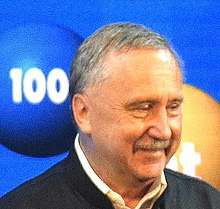Wacław Marzantowicz
Wacław Bolesław Marzantowicz[3] is a Polish mathematician known for his contributions in number theory and topology. He was President of Polish Mathematical Society between 2014–2019.
Wacław Bolesław Marzantowicz[1] | |
|---|---|
 Wacław Bolesław Marzantowicz | |
| Born | 18 June 1950 Poznań, Poland |
| Nationality | Polish |
| Alma mater |
|
| Awards | The Banach Prize of PMS (2003) |
| Scientific career | |
| Fields | Mathematics |
| Institutions | Adam Mickiewicz University |
| Thesis | Lefschetz Numbers of Maps Commuting with an Action of a Group(PhD) 13 May 1977 Habilitation 22 June[2] 1991 Professorship 15 March 2002[3] |
| Doctoral advisor | Kazimierz Gęba[4] |
| Website | www |
Biography
In 1967 he became the finalist of the 18th Mathematical Olympiad.[5] In 1972, he graduated in mathematics at Adam Mickiewicz University in Poznań. He obtained his doctorate in Institute of Mathematics of the Polish Academy of Sciences[1] in 1977, based on the work Lefschetz Numbers of Maps Commuting with an Action of a Group written under the direction Kazimierz Gęba.[6] He got habilitation there in 1991, based on the work Invariant topology methods used in variational problems.[2]
From 1993 to 1996, he was the director of the Institute of Mathematics University of Gdańsk. Since 1996, he has been working at Faculty of Mathematics and Computer Science at the Adam Mickiewicz University in Poznań, where he heads the "Department of Geometry and Topology". In 2002 he received the title of professor of mathematics.
From 1993 to 1996, he was the president of the Gdańsk Branch of Polish Mathematical Society (PMS) and next, he was the vice president of Polish Mathematical Society(2011–2013).[7] Since 2014, he has been the president of the Polish Mathematical Society.
He was recognized by the Stefan Banach Prize[8] of Polish Mathematical Society (ex aequo with Jerzy Jezierski.
Further reading
- Jerzy Jezierski; Wacław Marzantowicz, Homotopy methods in topological fixed and periodic points theory. Topological Fixed Point Theory and Its Applications, 3. Springer, Dordrecht, 2006. xii+319 pp. ISBN 978-1-4020-3930-0; ISBN 1-4020-3930-1, doi:10.1007/1-4020-3931-X.
- Złota księga nauk ekonomicznych, prawnych i ścisłych 2005, wyd. Gliwice 2005, p. 205
References
- "Wacław Bolesław Marzantowicz in Genealogy Project". Retrieved June 1, 2019.
- "Habilitations at the MI PAS(since 1969)". Archived from the original on 2015-04-06. Retrieved June 1, 2019.
- "prof. dr hab. Wacław Bolesław Marzantowicz". Nowa Nauka Polska (in Polish). National Information Processing Institute. Retrieved 19 July 2017.
- "Kazimierz Gęba in Genealogy Project". Retrieved June 1, 2019.]
- "Database of Mathematical Olympiad in Poland finalists". Polish Mathematical Society. March 2019. Archived from the original on May 13, 2018. Retrieved June 1, 2019.
- "PhDs at the MI PAS(since 1954)". Archived from the original on 2015-04-02. Retrieved June 1, 2019.
- "Władze PTM w latach 1919-2013". Polish Mathematical Society. March 2019. Archived from the original on June 1, 2019. Retrieved June 1, 2019.
- "Laureates of Stefan Banach Prize". Polish Mathematical Society. March 2019. Archived from the original on June 1, 2019. Retrieved June 1, 2019.